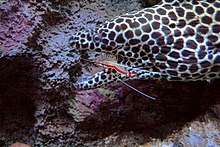(Demon Eel)Moray eel
| Moray eel Temporal range: Late Miocene–Recent [1] | |
|---|---|
 | |
| Scientific classification | |
| Kingdom: | Animalia |
| Phylum: | Chordata |
| Class: | Actinopterygii |
| Superorder: | Elopomorpha |
| Order: | Anguilliformes |
| Family: | Muraenidae |
| Genera | |
| See text. | |
Moray eels are cosmopolitan eels of the family Muraenidae. The approximately 200 species in 15 genera are almost exclusively marine, but several species are regularly seen in brackish water and a few, for example the freshwater moray (Gymnothorax polyuranodon) can sometimes be found in freshwater.[2]
With a maximum length of 11.5 centimetres (4.5 in), the smallest moray is likely the Snyder's moray (Anarchias leucurus),[3] while the longest species, the slender giant moray (Strophidon sathete) reaches up to 4 m (13 ft).[4] The largest in terms of total mass is the giant moray (Gymnothorax javanicus), which reaches 3 m (9.8 ft) in length and 30 kg (66 lb) in weight.[5]
Anatomy

Muraena helena showing typical moray eel morphology: robust anguilliform shape, lack of pectoral fins and circular gill openings
The dorsal fin extends from just behind the head along the back and joins seamlessly with the caudal and anal fins. Most species lack pectoral and pelvic fins, adding to their serpentine appearance. Their eyes are rather small; morays rely on their highly developed sense of smell, lying in wait to ambush prey.
The body is generally patterned. In some species, the inside of the mouth is also patterned. Their jaws are wide, framing a protruding snout. Most possess large teeth that are designed to tear flesh or grasp slippery prey items. A relatively small number of species, for example the snowflake moray (Echidna nebulosa) and zebra moray (Gymnomuraena zebra), primarily feed on crustaceans and other hard-shelled animals, and they have blunt, molar-like teeth suitable for crushing.[6]
Moray eels' heads are too narrow to create the negative pressure that most fish use to swallow prey. Quite possibly because of this, they have a second set of jaws in their throat called pharyngeal jaws, which also possess teeth. When feeding, morays launch these jaws into the mouth, where they grasp prey and transport it into the throat and digestive system. Moray eels are the only animal that uses pharyngeal jaws to actively capture and restrain prey.[7][8][9] Larger morays are capable of seriously wounding humans.
Morays secrete a protective mucus over their smooth, scaleless skin which in some species contains a toxin. Morays have much thicker skin and high densities of goblet cells in the epidermis that allows mucus to be produced at a higher rate than in other eel species. This allows sand granules to adhere to the sides of their burrows in sand-dwelling morays,[10] thus making the walls of the burrow more permanent due to the glycosylation of mucins in mucus. Their small circular gills, located on the flanks far posterior to the mouth, require the moray to maintain a gap in order to facilitate respiration.
Morays are carnivorous and feed primarily on other fish, cephalopods, molluscs, and crustaceans. Groupers, barracudas and sea snakes are among their few predators. There is a commercial fishery for several species, but some cause ciguatera fish poisoning.
Behavior
Cooperative hunting
Reef-associated roving coralgroupers (Plectropomus pessuliferus) have been observed to recruit morays to join them in hunting for food. The invitation to hunt is initiated by head-shaking. The rationale for this joining of forces is the ability of morays to enter narrow crevices and flush prey from niches not accessible to groupers. This is the only known instance of interspecies cooperative hunting among fish. Cooperation on other levels, such as at cleaning stations is well-known.[11][12]
Reputation
The morays are frequently thought of as particularly vicious or ill-tempered animals. In truth, morays hide from humans in crevices and would rather flee than fight. Morays are shy and secretive, and attack humans only in self-defence or mistaken identity. Most attacks stem from disruption of a moray's burrow (to which they do react strongly), but an increasing number also occur during hand-feeding of morays by divers, an activity often used by dive companies to attract tourists. Morays have poor vision and rely mostly on their acute sense of smell, making distinguishing between fingers and held food difficult; numerous divers have lost fingers while attempting hand feedings. For this reason the hand feeding of moray eels has been banned in some locations, including the Great Barrier Reef. The moray's rear-hooked teeth and primitive but strong bite mechanism also makes bites on humans more severe, as the eel cannot release its grip even in death and must be manually pried off. While the majority are not believed to be venomous, circumstantial evidence suggests that a few species may be.[6]
Eels that have eaten certain types of toxic algae, or more frequently that have eaten fishes that have eaten some of these algae, can cause ciguatera fish poisoning if eaten. Morays rest in crevices during the day and hunt nocturnally, although they may ensnare small fish and crustaceans that pass near them during the day.[12]
Habitat
Moray eels are cosmopolitan, found in both tropical and temperate seas, although the largest species richness is at reefs in warm oceans. Very few species occur outside the tropics or subtropics, and the ones that do only extend marginally beyond these regions. They live at depths of up to several hundred metres, where they spend most of their time concealed inside crevices and alcoves. While several species regularly are found in brackish water, very few species can be found in freshwater, for example the freshwater moray (Gymnothorax polyuranodon) and the pink-lipped moray eel (Echidna rhodochilus).
Taxonomy
Genera
More Stories: http://blackboxfishtalk.blogspot.com/





No comments:
Post a Comment